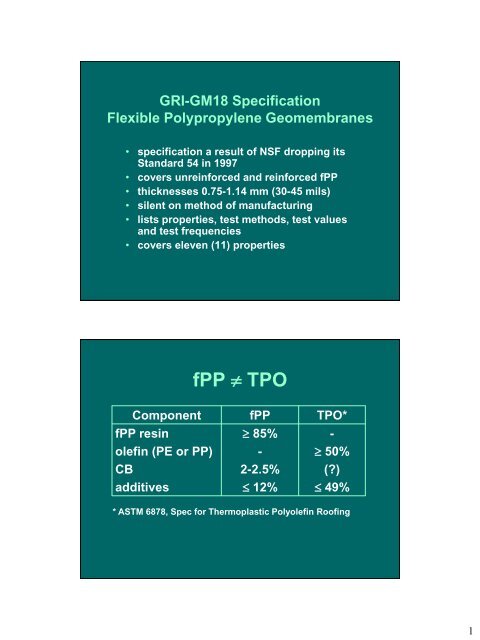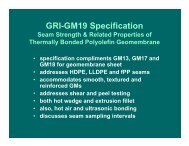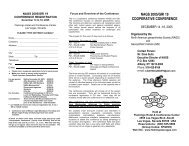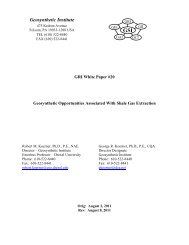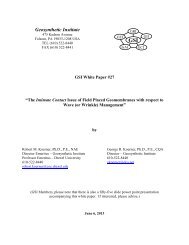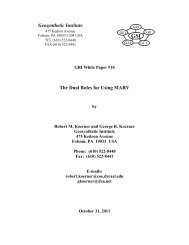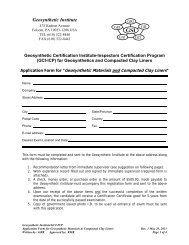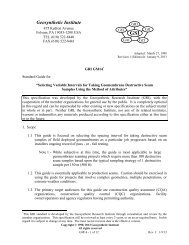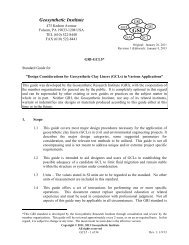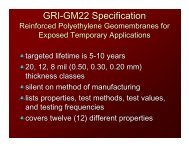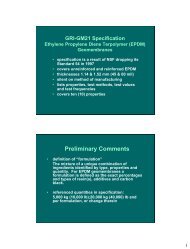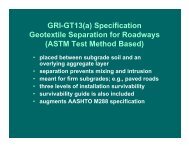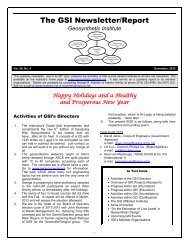Power Point Tutorial - The Geosynthetic Institute
Power Point Tutorial - The Geosynthetic Institute
Power Point Tutorial - The Geosynthetic Institute
- No tags were found...
You also want an ePaper? Increase the reach of your titles
YUMPU automatically turns print PDFs into web optimized ePapers that Google loves.
GRI-GM18 Specification<br />
Flexible Polypropylene Geomembranes<br />
• specification a result of NSF dropping its<br />
Standard 54 in 1997<br />
• covers unreinforced and reinforced fPP<br />
• thicknesses 0.75-1.14 mm (30-45 mils)<br />
• silent on method of manufacturing<br />
• lists properties, test methods, test values<br />
and test frequencies<br />
• covers eleven (11) properties<br />
fPP TPO<br />
Component fPP TPO*<br />
fPP resin<br />
olefin (PE or PP)<br />
CB<br />
additives<br />
85%<br />
-<br />
2-2.5%<br />
12%<br />
-<br />
50%<br />
()<br />
49%<br />
* ASTM 6878, Spec for <strong>The</strong>rmoplastic Polyolefin Roofing<br />
1
Preliminary Comments<br />
• definition of “formulation”<br />
<strong>The</strong> mixture of a unique combination of ingredients<br />
identified by type, properties and quantity. For fPP<br />
geomembranes a formulation is defined as the exact<br />
percentages and types of resin(s), additives and carbon<br />
black.<br />
• referenced quantities in specification<br />
22,000 kg = 45,000 lb ~ 50 rolls of 0.75 mm (30 mil)<br />
7,500 kg = 15,000 lb ~ 20 rolls of 0.75 mm (30 mil)<br />
Physical Properties<br />
1. mass/unit area<br />
Mechanical Properties<br />
3. tensile<br />
4. multiaxial<br />
5. tear<br />
Endurance Properties<br />
9. CB content<br />
2. thickness<br />
6. puncture<br />
7. ply-adhesion<br />
8. low temp. flex.<br />
10. oven aging<br />
11. UV resistance<br />
2
1. Mass per Unit Area<br />
• generally referred as “weight”<br />
• follows ASTM D5261<br />
• 5 specimens across roll width<br />
• values averaged and compared to<br />
spec value stated as “min. ave.”<br />
• straightforward test<br />
ASTM D5261<br />
“Weight”<br />
3
2. Thickness<br />
• follows ASTM D5199<br />
• dead weight micrometer with flat tip<br />
• includes scrim when reinforced<br />
• 10-specimens across roll width<br />
• required for each roll<br />
• average must equal nominal<br />
• lowest individual is –10%<br />
D5199<br />
Thickness Test<br />
Smooth Sheet<br />
4
3. Tensile Properties<br />
• ASTM D6693 for unreinforced (dogbone)<br />
• ASTM D751 for reinforced (grab)<br />
• min. ave. of 5 MD and 5 XMD<br />
Property Method Unreinforced Reinforced<br />
strength<br />
elongation<br />
dogbone<br />
grab<br />
dogbone<br />
grab<br />
• every 7500 kg (15,000 lb) ~ 20 rolls<br />
13 MN/m 2 (1900 lb/in 2 ) n/a<br />
965 N/mm (5600 lb/in.)<br />
700%<br />
n/a<br />
n/a<br />
22%<br />
ASTM D6693 Type IV<br />
Test Specimens<br />
5
D6693 Type IV<br />
“Dogbone”<br />
Test in Progress<br />
ASTM D751 – Grab Tensile Test (Measures Strength and Elongation)<br />
6
4. Multiaxial Tension<br />
(also called axisymmetric)<br />
• follows ASTM D5617<br />
• it’s a huge “burst” type of test<br />
• simulates out-of-plane deformation<br />
• measures pressure and deformation<br />
• calculations give strength and<br />
elongation<br />
• spec only requires elongation 120%<br />
• only for nonreinforced fPP<br />
• required for each formulation<br />
ASTM D5617<br />
Multiaxial<br />
“Burst”<br />
7
5. Tear Resistance<br />
• uses ASTM D1004 (90 deg. tear test)<br />
for nonreinforced – 10 MD and 10 XMD<br />
• uses ASTM D5884 (tongue tear test)<br />
for reinforced – 5 MD and 5 XMD<br />
• nonreinforced 50 N/mm (300 lb/in.)<br />
• reinforced 245 N (55 lb)<br />
• every 7500 kg (15,000 lb) ~ 20 rolls<br />
D1004<br />
90° Tear Test<br />
8
D5884<br />
Tongue Tear<br />
6. Puncture Resistance<br />
• follows ASTM D4833<br />
• called “pin” puncture<br />
• min. ave. of 15 tests<br />
• nonreinforced 130 N/mm (800 lb/in.)<br />
• reinforced 350 N/mm (2000 lb/in.)<br />
• every 7,500 kg (15,000 lb) ~ 20 rolls<br />
9
ASTM D4833 – “Pin” Puncture Resistance<br />
7. Ply Adhesion<br />
• follows ASTM D6636<br />
• for scrim reinforced fPP only<br />
• specimen is 25 mm wide (1.0 in.) wide<br />
• length 200 mm (8.0 in.)<br />
• average of 5 tests (MD only)<br />
• average value 65 N (15 lb)<br />
• every 7500 kg (15,000 lb) ~ 20 rolls<br />
10
ASTM D6636 – Ply Adhesion Test<br />
8. Low Temperature Flexibility<br />
• follows ASTM D2136<br />
• must resist cracking at -40°C (-40°F)<br />
• incubation for 4-hours followed by<br />
bending over a mandrel<br />
• bent over 3.2 mm (1/8 in.) mandrel<br />
• performed once per formulation<br />
11
9. Carbon Black Content<br />
• follows ASTM D1603 (combustion<br />
boat placed in tube furnace)<br />
• muffle furnace (D4218) or microwave<br />
O.K. if correlation is established<br />
• ave. of two tests in 2.0 to 3.0% range<br />
• every 22,000 kg (45,000 lb) ~ 50 rolls<br />
12
Combustion Boat<br />
in Tube Furnace<br />
D1603<br />
Muffle Furnace<br />
D4218<br />
13
10. Oven Aging<br />
• assessment of thermal stability of<br />
antioxidants (AOs)<br />
• follows ASTM D5721<br />
• forced air oven at 85°C<br />
• Std.-OIT is not recommended<br />
• HP-OIT 60% ret. after 90 days (black)<br />
• HP-OIT 50% ret. after 90 days<br />
(other colors)<br />
• frequency is per formulation<br />
D5721<br />
Forced Air<br />
Oven<br />
14
Oxidative Induction Time<br />
• OIT is an indirect measure of the amount of<br />
antioxidants<br />
• HP-OIT, per ASTM D5885, is specified<br />
• small specimen ~ 2 mg<br />
• pressure at 3500 kPa (500 lb/in. 2 )<br />
• temperature at 150°C in N 2 ; 1-min. dwell;<br />
switch to 0 2 ; record time; see following<br />
HIP-OIT (ASTM D5885)<br />
15
D5885<br />
HP-OIT<br />
In Addition to OIT Criteria<br />
• incubated specimen cannot crack<br />
• follows GRI GM16 test method<br />
• 180 deg. bending within a holder<br />
• visual observation for cracks at 7X<br />
magnification’ “go” or “no-go”<br />
test<br />
16
Test Specimen as Removed from Weathering Device, Bent 180 deg.<br />
and Clamped Between Two Wooden Blocks and One of the Clamping Blocks<br />
11. Ultraviolet Resistance<br />
• assessment of UV stability of the AOs and CB<br />
(there should be synergy)<br />
• uses a laboratory weatherometer<br />
• follows GRI GM11 (~ ASTM G154)<br />
• called “ultraviolet fluorescent device”<br />
• 20 hr. UV cycle at 75°C, then 4 hr. condensation<br />
at 60°C<br />
• HP-OIT 80% ret. after 1600 hrs. (black)<br />
• HP-OIT 60% ret. after 1600 hrs. (other colors)<br />
• also, no cracking after incubation per GRI GM16<br />
• frequency is per formulation<br />
17
GRI-GM11<br />
Ultraviolet<br />
Fluorescent<br />
Weathering Device<br />
Regarding the Warranty<br />
• manufacturers requested so as to avoid 20-year<br />
warranties and foolish expenses<br />
• based on GRI Report #16, i.e., if AOs are present<br />
lifetime ~ 200 yrs.<br />
• GM18 was crafted to be sure the AOs are present<br />
and of proper type, i.e., OIT and oven aging<br />
verification<br />
• also, for geomembrane used in exposed conditions<br />
a UV exposure is included<br />
• recommended material warranty using GM18 spec is<br />
for 5-years (it promises to be 100’s)<br />
• GM18 is silent on any type of installation warranty<br />
(this is the major concern)<br />
18
Concluding Comments<br />
• specification addresses both covered and<br />
exposed GM installations<br />
• this is MQC specification i.e., the<br />
manufacturers required tests, minimum<br />
values and frequencies<br />
• if MQA project specific spec is more<br />
restrictive, manufacturer may ask for<br />
additional compensation<br />
<strong>The</strong> Basic Tables Follow<br />
fPP & fPP-R – SI Units<br />
fPP & fPP-R – English Units<br />
Note: <strong>The</strong> most recent version of this specification (text<br />
and tables) is available on the GSI Web Site<br />
.<br />
19


